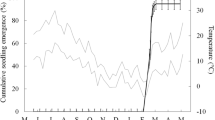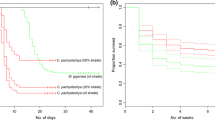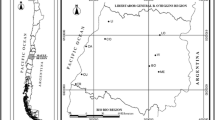Abstract
Germination of three closely related species from the Myosotis palustris group (M. nemorosa, M. palustris subsp. laxiflora, M. caespitosa) differing in their habitats and capacity for clonal growth, was compared in two greenhouse experiments. To evaluate both inter- and intraspecific variation, each species was represented by seeds from several populations. Final germination percentage and germination rates T50 were compared both between species and populations within species. In the first experiment, we studied the influence of two external factors, moisture and light. Four moisture levels (dry, wet, periodically flooded and permanently flooded soil) and three types of shading (without shading, shaded with green foil, shaded with solid paper sheet) were combined in a complete factorial design. In all three species, total germination percentage was the same in the three wettest treatments, and decreased in the dry treatment. Germination in the treatments shaded with green foil (simulating vegetation cover, which changed light quality) was significantly slower than in treatments without shading and treatments shaded with a solid paper sheet. There were significant differences among species, but we also found very pronounced differences among populations within a species. M. caespitosa had the uniformly highest germination percentage (reaching in some cases 100%) and also fastest germination. Germination of M. palustris subsp. laxiflora populations was slower and reached lower final proportions, and medium variability among populations. Inter-population variability in the final germination percentage was highest, and the final germination the lowest in M. nemorosa. In addition, M. nemorosa, a species typical for permanent meadow communities was delayed by permanent flooding. In the second experiment, we studied the effects of seed age and storage conditions. Three combinations of seed age and storage were used: younger seeds (half year old) with no-chilling, younger seeds with chilling and old seeds (three years old) with chilling. M. caespitosa had again the highest final germination percentage and fastest germination rates T50. In addition, final germination percentage of this species slightly increased with seed age, whereas it decreased in the other two species. The germination behaviour corresponded well to expectation based on species life histories and habitat preferences. Remarkably stable and high germination percentages and fastest germination rates T50 were ascertained in M. caespitosa, a species of disturbed habitats, with lowest capacity for clonal spread. M. palustris subsp. laxiflora (species with highest clonal capacity) and M. nemorosa (species with medium clonal potential) achieved lower, but still very high final germination percentage. In addition, M. nemorosa showed the highest inter-populations variability in our experiments.






Similar content being viewed by others
References
Adler W, Oswald K, Fischer R (1994) Exkursionsflora von Österreich. Eugen Ulmer Verlag, Stuttgart & Wien
Albrecht G, Biemelt S, Baumgartner S (1997) Accumulation of fructans following oxygen deficiency stress in related plant species with different flooding tolerances. New Phytol 136:137–144
Baskin CC, Baskin JM (1998) Seeds: ecology, biogeography, and evolution of dormancy and germination. Academic Press, San Diego
Bekker RM, Oomes MJM, Bakker JP (1998) The impact of groundwater level on soil seed bank survival. Seed Sci Res 8:399–404
Chaloupecká E (2003) Porovnání biologie druhů komplexu Myosotis palustris (Comparative biology of Myosotis palustris group). MSc. Thesis, University of South Bohemia, České Budějovice (in Czech)
Chaloupecká E, Lepš J (2004) Equivalence of competitor effects and tradeoff between vegetative multiplication and generative reproduction: case study with Lychnis flos-cuculi and Myosotis nemorosa. Flora 199:157–167
Fenner M (1992) Seeds: The ecology of regenaration in plant communities. Redwood Books, Trowbridge
Grau J, Merxmüller H (1972) Myosotis. L. In Tutin TG et al. (eds) Flora Europaea 3. Cambridge University Press, Cambridge, pp. 111–117
Grime JP (2001) Plant strategies, vegetation processes and ecosystem properties. Ed. 2, John Wiley & Sons, Chichester
Grime JP, Mason G, Curtis AV, Rodman J, Band SR, Mowforth MAG, Neal AM, Shaw S (1981) A comparative study of germination characteristics in a local flora. J Ecol 69:1017–1059
Grime JP, Hodgson JG, Hunt R (1987) Comparative plant ecology: a functional approach to common British species. Unwin Hyman, London
Grubb PJ (1977) The maintenance of species-richness in plant communities: the importance of the regeneration niche. Biol Rev 52:107–145
Hegi G (1979) Illustrierte Flora von Mitteleuropa. Band III, Teil 2. Verlag Paul Parey, Berlin
Jensen K (1998) Species composition of soil seed bank and seed rain of abandoned wet meadows and their relation to aboveground vegetation. Flora 193:345–359
Klimešová J, Klimeš L (1998) CLOPLA1 (CLOnal PLAnts, version 1) – a database of clonal growth in plants of central Europe. Available at: http://www.butbn.cas.cz/klimes/
Klotz S, Kühn I, Durka W (2002) BIOLFLOR - Eine Datenbank mit biologisch-ökologischen Merkmalen zur Flora von Deutschland. Landwirtschaftsverlag, Bonn – Bad Godesberg
Kotorová I, Lepš J (1999) Comparative ecology of seedling recruitment in an oligotrophic wet meadow. J Veg Sci 10:175–186
Krahulec F, Marhold K, Schmid B (1999) Ecology of closely related plant species: An introduction. Folia Geobot 34:1–5
Lavorel S, Garnier E (2002) Predicting changes in community composition and ecosystem functioning from plant traits: revisiting the Holy Grail. Funct Ecol 16:545–556
Leck MA, Parker VT, Simpson RL (eds) (1989) Ecology of seed banks. Academic Press, San Diego
Lenssen JPM, ten Dolle GE, Blom CWPM (1998) The effect of flooding on the recruitment of reed marsh and tall forb plant species. Pl Ecol 139:13–23
Lenssen JPM, Menting FBJ, Van der Putten WH (2003) Plant responses to simultaneous stress of waterlogging and shade: amplified of hierarchical effects? New Phytol 157:281–290
Milberg P, Andersson L, Thompson K (2000) Large-seeded spices are less dependent on light for germination than small-seeded ones. Seed Sci Res 10:99–104
Pons TL (1992) Seed responses to light. In Fenner M (ed) Seeds: The ecology of regeneration in plant communities. Redwood Books, Trowbridge, pp 259–283
Przywara L (1983) Further caryological studies on the series Palustres M. Pop. of the genus Myosotis L. from Poland. Acta Biol Cracov, Ser Bot 25:85–101
Rice KJ, Dyer AR (2001) Seed aging, delayed germination and reduced competitive ability in Bromus tectorum. Pl Ecol 155:237–243
Ritland K (1983) The joint evolution of seed dormancy and flowering time in annual plants living in variable enviroments. Theor Populat Biol 24:213–243
Schuster R (1967) Taxonomische Untersuchungen über die Serie Palustres M. Pop. der Gattung Myosotis L. Feddes Repert 74:39–98
Silvertown JW, Charlesworth D (2001) Introduction to plant population biology. Blackwell Science, Oxford
Skálová H, Krahulec F (1992) The response of three Festuca rubra clones to changes in light quality and plant density. Funct Ecol 6:282–290
Špačková I, Kotorová I, Lepš J (1998) Sensitivity of seedling recruitment to moss, litter and dominant removal in an oligotrophic wet meadow. Folia Geobot 33:17–30
Špačková I, Lepš J (2004) Variability of seedling recruitment under dominant, moss, and litter removal over four years. Folia Geobot 29:41–55
StatSoft, Inc. (2005) STATISTICA 7. Electronic manual. Tulsa, Oklahoma. Available at: http://www.statsoft.com
Štěpánková J (1993) Ploidy variation in the group of Myosotis palustris and M. laxa in the Czech Republic and Slovakia. Folia Geobot Phytotax 28:113–128
Štěpánková J (2000) 16. Myosotis L. – pomněnka. In Slavík B (ed), Květena ČR 6 (Flora of the Czech Republic, vol. 6). Academia, Praha, pp 216–234 (in Czech)
Štěpánková J (2002) 14. Myosotis L. – pomněnka (Boraginaceae Juss.). In Kubát K, Hrouda L, Chrtek J jun., Kaplan Z, Kirschner J, Štěpánek J (eds) Klíč ke květeně České republiky (Key to the flora of the Czech Republic). Academia, Praha, pp 526–530 (in Czech)
Thompson K, Bakker J, Bekker R (1997) The soil seed bank of North West Europe: methodology, density and longevity. Cambridge University Press, Cambridge
Van den Broek T, van Diggelen R, Bobbing R (2005) Variation in seed buoyancy of species in wetland ecosystems with different flooding dynamics. J Veg Sci 16:579–586
Venable DL, Brown JS (1988) The selective interactions of dispersal, dormancy, and seed size as adaptation for reducing risk in variable environments. Amer Naturalist 131:360–384
Weiterová I (2008) Seasonal and spatial variance of seed bank species composition in an oligotrophic wet meadow. Flora 203:204–214
Zelený D (1999) Vliv bioticky generované heterogenity na klíčení semenáčků v lučním porostu (Effect of biotically generated heterogeneity on seedling recruitment in a meadow community). BSc. Thesis, University of South Bohemia, České Budějovice (in Czech)
Acknowledgement
The study was supported by the grants of Granting Agency of the Czech Republic (206/03/H034 and 206/09/1471), and Czech Ministry of Education (6007665801 and LC06073). We are grateful to Keith Edwards for editing the English.
Author information
Authors and Affiliations
Corresponding author
Appendices
Appendix 1. Localities of seeds collected for Experiment 1.
Abbreviations of species: C - M. caespitosa, L - M. laxiflora, N - M. nemorosa
Pop. nr. | Species | Coordinates | Altitude (m) | Locality | Habitat type |
1 | C | 49°38′ N, 15°54′ E | 610 | Dářko | growth forbs at the margin of “Nový rybník” pond |
2 | C | 48°46′ N, 14°48′ E | 550 | Veveřský rybník | margin of “Veveřský” pond |
3 | C | 49°04′ N, 14°21′ E | 385 | U Vomáčků | margin of “U Vomáčků” pond |
4 | C | 49°03′ N, 14°23′ E | 385 | Přední Topole | margin of “Přední Topole” pond |
5 | C | 49°04′ N, 14°22′ E | 385 | Mydlovarský rybník | margin of “Mydlák” pond |
6 | L | 48°54′ N, 14°36′ E | 480 | Trocnov | sandy deposit of brook |
7 | L | 48°52′ N, 14°22′ E | 440 | Plešovice | bank of “Vltava” river |
8 | L | 48°49′ N, 14°20′ E | 460 | Český Krumlov | alluvial deposit at “Vltava” river |
9 | L | 49°00′ N, 14°50′ E | 430 | Stará řeka | alder carr near “Dušákovský” pond |
10 | L | 49°01′ N, 14°50′ E | 430 | Lužnice | sandy alluvial deposit at “Lužnice” river bank |
11 | N | 48°57′ N, 14°36′ E | 515 | Ohrazení | a wet, oligotrophic, species-rich meadow |
12 | N | 48°58′ N, 14°33′ E | 510 | Třebotovice | a ditch separating road and wood |
13 | N | 49°20′ N, 15°01′ E | 640 | Benešov | a wet, oligotrophic meadow |
14 | N | 49°26′ N, 15°18′ E | 585 | Džbán | a meadow margin neighbouring with wood |
15 | N | 49°25′ N, 14°12′ E | 390 | Zvíkov | a ditch along a road |
Appendix 2. Localities of seeds collected for Experiment 2.
Abbreviations of species: C - M. caespitosa, L - M. laxiflora, N - M. nemorosa. Abbreviations of age: Y - “younger” (collected in 2005); O - “old” (collected in 2003)
Pop. nr. | Species | Age | Coordinates | Altitude (m) | Locality | Habitat type |
1 | C | Y | 49°04′ N, 14°24′ E | 380 | Munický rybník | margin of “Munický” pond |
2 | C | Y | 49°04′ N, 14°22′ E | 385 | Mydlovarský rybník | margin of “Mydlák” pond |
3 | C | Y | 48°46′ N, 14°48′ E | 550 | Veveřský rybník | margin of “Veveřský” pond |
4 | C | Y | 49°23′ N, 15°33′ E | 570 | Rybník Lukáš | margin of “Lukáš” pond |
5 | C | Y | 49°38′ N, 15°54′ E | 610 | Dářko | growth of forbs at the margin of “Nový rybník” pond |
6 | L | Y | 49°00′ N, 14°50′ E | 430 | Stará řeka | alder carr near “Dušákovský” pond |
7 | L | Y | 49°22′ N, 15°35′ E | 520 | Rančířov | margin of the meadow near “Jihlava” river |
8 | L | Y | 48°54′ N, 14°36′ E | 480 | Trocnov | sandy deposit of brook |
9 | N | Y | 48°57′ N, 14°35′ E | 510 | Kaliště-cesta | woody path |
10 | N | Y | 48°57′ N, 14°35′ E | 495 | Kaliště-louka | wet meadow |
11 | N | Y | 49°19′ N, 15°28′ E | 580 | Jezdkovické rašeliniště | small pond in the “Jezdkovické“ mire |
12 | N | Y | 49°22′ N, 15°33′ E | 580 | Vysoká | overgrown wet meadow along brook |
13 | N | Y | 48°54′ N, 14°36′ E | 660 | Milíčovské rašeliniště | “Milíčovské” mire |
14 | N | Y | 49°26′ N, 15°23′ E | 610 | Jankovský potok | margin of “Jankovský” brook |
15 | C | O | 49°04′ N, 14°21′ E | 385 | U Vomáčků | margin of “U Vomáčků” pond |
16 | C | O | 49°03′ N, 14°23′ E | 385 | Přední Topole | margin of “Přední Topole” pond |
17 | C | O | 48°46′ N, 14°48′ E | 550 | Veveřský rybník | margin of “Veveřský” pond |
18 | C | O | 49°38′ N, 15°54′ E | 610 | Dářko | growth of forbs at the margin of “Nový rybník” pond |
19 | L | O | 48°52′ N, 14°22′ E | 440 | Hvízdal | bank of “Vltava” river |
20 | L | O | 49°00′ N, 14°50′ E | 430 | Stará řeka | alder carr near “Dušákovský” pond |
21 | L | O | 48°49′ N, 14°20′ E | 460 | Český Krumlov | alluvial deposit at “Vltava” river |
22 | L | O | 48°54′ N, 14°36′ E | 480 | Trocnov | sandy deposit of brook |
23 | L | O | 49°01′ N, 14°50′ E | 430 | Lužnice | sandy alluvial deposit at “Lužnice” river bank |
24 | N | O | 48°57′ N, 14°36′ E | 515 | Ohrazení | a wet, oligotrophic, species-rich meadow |
25 | N | O | 49°20′ N, 15°01′ E | 640 | Benešov | a wet, oligotrophic meadow |
26 | N | O | 48°58′ N, 14°33′ E | 510 | Třebotovice | a ditch separating road and wood |
27 | N | O | 49°25′ N, 15°21′ E | 640 | U Vyskytenské hájovny | an alder carr |
28 | N | O | 49°25′ N, 14°12′ E | 390 | Zvíkov | a ditch along a road |
Rights and permissions
About this article
Cite this article
Koutecká, E., Lepš, J. Effect of Light and Moisture Conditions and Seed Age on Germination of Three Closely Related Myosotis Species. Folia Geobot 44, 109–130 (2009). https://doi.org/10.1007/s12224-009-9038-9
Received:
Accepted:
Published:
Issue Date:
DOI: https://doi.org/10.1007/s12224-009-9038-9




